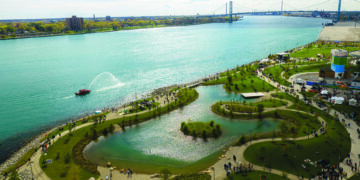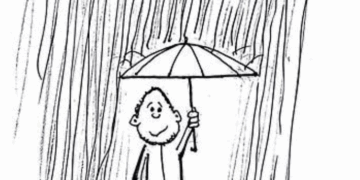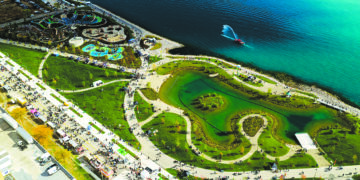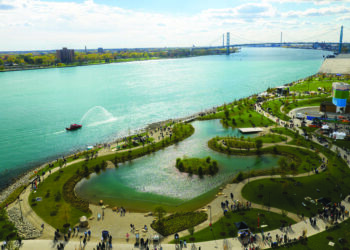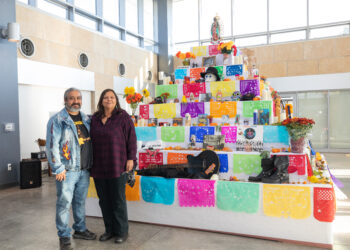For much of the 1900s, the 22-acre west riverfront site, located about two-thirds of a mile east of the Ambassador Bridge, functioned as a rail yard. From 1979 through 2007, the Detroit Free Press operated a printing plant on this site. Then, the Detroit Riverfront Conservancy purchased the property to become part of the Detroit RiverWalk. Today, it is home to the new $80 million Ralph C. Wilson, Jr. Centennial Park which has been described as a dynamic public gathering place that will be transformative for Detroit and its metropolitan region.
Wilson Park is not just any park. It is a multidimensional riverfront destination intended to draw people from Detroit and across the region, including all age groups. Early reports are that it is soundly resonating with all.
The park is named in honor of Ralph Wilson who was an entrepreneur, philanthropist, longtime resident of Detroit, and founder and owner of the Buffalo Bills football team. Money from the sale of the Buffalo Bills was used to create a Ralph C. Wilson, Jr. Foundation that has contributed substantially to Ralph C. Wilson, Jr. Centennial Parks in both Buffalo, NY and Detroit.
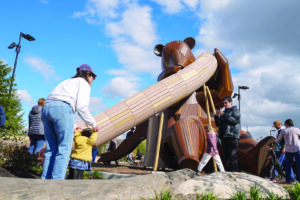
Detroit’s Wilson Park was designed by the world-renowned Michael Van Valkenburgh Associates, with support from many local architecture and engineering firms and substantial local input from a 21-member Community Action Team made up of Detroit residents. This community input was invaluable from the outset. The end result is an amazing riverfront gathering place that inspires play and outdoor recreation, wellness, and connection to Corktown and Mexicantown neighborhoods through the Southwest Greenway and to all of Detroit through the 28-mile Joe Louis Greenway.
Key park features include a two-and-a-half-acre Huron-Clinton Metroparks Water Garden that provides much-needed coastal wetland habitat and an opportunity for park visitors to interact with nature, learn about conservation, and participate in environmental education. It is one of the few places along the Detroit River, along with Belle Isle, where kids and families can touch and feel the water. This water garden is a form of wetlands, often called “nurseries of life” because they support thousands of species. The Detroit River has lost 97% of its coastal wetlands to commercial and industrial development, so Wilson Park represents a net gain in these rare habitats.
Along the Wilson Park shoreline are a variety of habitats, including more than 20 triangular wooden lunker structures that will create cover and resting areas for fish, 12 hollow, semicircular concrete structures called reef balls that enhance habitat for fish and invertebrates, a 50 by 150-foot fish spawning reef for walleye, smallmouth bass, and lake sturgeon, and the Barbara Erb Cove that is designed to both enhance shoreline habitat and allow visitors to interact with the water.
The park also includes the William Davidson Sport House with two full-sized outdoor basketball courts that can also be used for pickleball, volleyball, and even roller skating. An attraction for kids is the Delta Dental Play Garden that features giant slides like the 20-foot Bernstein Bear slide and a river otter slide, swings, nature-based play structures, play zones that inspire imagination, and even a tot lot for little ones.
Another attraction is the DTE Foundation Summit that serves as a place for passive recreation like picnicking and relaxing, as well as a venue for year-round events such as concerts, movie nights, outdoor fitness classes, and winter sledding. Trails meander throughout the park, and each turn provides a new vista and perspective on Detroit and Windsor, Ontario. And of course, there are many places to just sit and reflect, and be inspired with a sense of wonder.
Wilson Park will clearly become a centerpiece of the Detroit Riverwalk. It will help further Detroit’s reputation as a destination city. For example, Travel +Leisure identified Detroit as one of the 50 best places to travel in 2025.
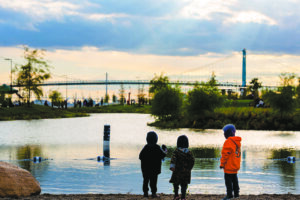
Wilson Park is also another important building block in changing the national and international perception of Detroit being a Rust Belt city to one of a leader in sustainable redevelopment. The Detroit RiverWalk and its Wilson Park are a good example of how public-private partnerships can create world-class public waterfront gathering places that improve quality of life and help attract and retain employees for businesses.
Most people are still disconnected from nature. For example, a new research study reported in The Guardian has shown that people’s connection to nature has declined by more than 60% since 1800. Wilson Park will help change this trend in Detroit. Further, most people recognize that there is limited greenspace in Southwest Detroit. Wilson Park is a green oasis in this community that clearly deserves more trees and natural open spaces. Connections to nature and outdoor recreation can also improve health.
It should also be pointed out that the synergy among Wilson Park, the Southwest Greenway, the Joe Louis Greenway, and restored Michigan Central Station will result in economic benefits to Mexicantown.
This park and the Detroit Riverwalk will also become a destination of choice for cross-border trail tourism once the new Gordie Howe International Bridge opens in 2026. Wilson Park and the Detroit Riverwalk will be connected to the Joe Louis Greenway, Michigan’s Iron Belle Trail, The Great Lakes Way, and Canada’s trails and parks by this new border crossing with a dedicated bicycle and pedestrian lane. And there will be no bridge toll if crossing the bridge on foot or by bicycle. By next year, half-day bike rides can be taken from Wilson Park to the proposed Ojibway National Urban Park at the foot of the bridge in Windsor.
To me, Ralph Wilson Park is a dream come true. The Detroit Riverfront Conservancy and its many partners have cleaned up an industrial brownfield, restored habitats, and created a beautiful, exciting, safe, and accessible world-class gathering place for all. I have already brought my three granddaughters to the park, and they said that “it is the best park ever.” And I hope that they bring their children someday.
Wilson Park is another transformational project in Detroit, showing why this city is such a great place to live, work, and play. And what a place to make memories, and what a gift to future generations.
******
John Hartig is an accomplished Great Lakes scientist and nonfiction author who has penned over 150 publications on the Great Lakes, including eight books. He serves on the Board of Directors of the Detroit Riverfront Conservancy and as a Visiting Scholar at the University of Windsor’s Great Lakes Institute for Environmental Research. For 14 years, he served as Refuge Manager for the Detroit River International Wildlife Refuge.
Columnista de invitado
Reflexiones sobre el Ralph Wilson Centennial Park
Durante gran parte del siglo XX, las 22 acres del terreno ubicado en la ribera oeste del río —a unas dos terceras partes de una milla al este del Ambassador Bridge— funcionaron como un patio de trenes. De 1979 a 2007, el Detroit Free Pressoperó ahí su planta de impresión. Después, el Detroit Riverfront Conservancy compró la propiedad para integrarla al Detroit RiverWalk. Hoy, ese espacio es el nuevo Ralph C. Wilson, Jr. Centennial Park, una inversión de 80 millones de dólares que ha sido descrita como un lugar público dinámico que transformará a Detroit y su región metropolitana.
El Wilson Park no es cualquier parque. Es un destino multifuncional junto al río, pensado para atraer a personas de toda la ciudad y la región, de todas las edades. Los primeros reportes indican que está conectando profundamente con la comunidad.
El parque lleva el nombre de Ralph Wilson, empresario, filántropo, residente de Detroit por muchos años y fundador y dueño del equipo de futbol americano Buffalo Bills. Con el dinero proveniente de la venta de ese equipo se creó la Ralph C. Wilson, Jr. Foundation, la cual ha contribuido generosamente a los parques conmemorativos Ralph C. Wilson, Jr. Centennial tanto en Buffalo, Nueva York, como en Detroit.

El diseño de Wilson Park estuvo a cargo de la reconocida firma Michael Van Valkenburgh Associates, con apoyo de varias empresas locales de arquitectura e ingeniería, y con una valiosa participación comunitaria a través de un Community Action Team de 21 residentes de Detroit. Desde el principio, esa aportación vecinal fue fundamental. El resultado final es un espacio frente al río que inspira el juego, la recreación al aire libre, el bienestar y la conexión con los barrios de Corktown y Mexicantown mediante el Southwest Greenway, y con toda la ciudad a través del Joe Louis Greenway, que abarca 28 millas.
Entre los elementos principales del parque se encuentra el Huron-Clinton Metroparks Water Garden, un jardín acuático de dos acres y medio que ofrece hábitat costero esencial y la oportunidad de que los visitantes interactúen con la naturaleza, aprendan sobre conservación y participen en educación ambiental. Es uno de los pocos lugares en el río Detroit, junto con Belle Isle, donde niñas, niños y familias pueden tocar y sentir el agua. Este jardín acuático es una forma de humedal, a menudo llamados “cunas de vida”, porque sustentan miles de especies. Dado que el río Detroit ha perdido el 97% de sus humedales costeros por el desarrollo comercial e industrial, Wilson Park representa una ganancia neta de estos hábitats tan escasos.
A lo largo de la orilla del parque hay una variedad de ambientes naturales, incluyendo más de 20 estructuras triangulares de madera llamadas lunkers que sirven como refugio para los peces; 12 estructuras semicirculares de concreto llamadas reef balls que aumentan el hábitat para peces e invertebrados; un arrecife de desove de 50 por 150 pies para especies como walleye, smallmouth bass y esturión del lago; y la Barbara Erb Cove, diseñada para mejorar el hábitat costero y permitir que los visitantes se acerquen al agua.
El parque también cuenta con el William Davidson Sport House, con dos canchas deportivas al aire libre de tamaño reglamentario que pueden usarse para basquetbol, pickleball, voleibol e incluso patinaje. Una de las principales atracciones para los niños es el Delta Dental Play Garden, con toboganes gigantes como el de los osos Bernstein de 20 pies de altura y el tobogán de nutria del río, columpios, estructuras de juego inspiradas en la naturaleza, zonas que estimulan la imaginación y un área especial para los más pequeños.
Otra área destacada es el DTE Foundation Summit, un espacio ideal para descansar o disfrutar de un picnic, además de servir como sede para eventos durante todo el año: conciertos, noches de cine, clases de ejercicio al aire libre y hasta trineadas en invierno. Los senderos serpentean por todo el parque, ofreciendo en cada curva una nueva vista de Detroit y Windsor, Ontario. Y, por supuesto, hay muchos lugares donde simplemente sentarse, reflexionar y dejarse inspirar por el entorno.

El Wilson Park sin duda se convertirá en una pieza central del Detroit Riverwalk, reforzando la reputación de Detroit como una ciudad destino. Por ejemplo, Travel + Leisure la nombró entre los 50 mejores lugares para visitar en 2025.
Este parque también representa otro paso importante para cambiar la percepción nacional e internacional de Detroit: de una ciudad industrial del “Rust Belt” a un modelo de reurbanización sostenible. El Detroit RiverWalk y su Wilson Park son un claro ejemplo de cómo las alianzas público-privadas pueden crear espacios frente al agua de clase mundial que mejoran la calidad de vida y ayudan a atraer y retener talento para las empresas locales.
Muchas personas siguen desconectadas de la naturaleza. Un estudio reciente, citado por The Guardian, muestra que la conexión de la gente con la naturaleza ha disminuido más del 60% desde 1800. El Wilson Park ayudará a revertir esa tendencia en Detroit. Además, todos reconocen que en el suroeste de la ciudad hay pocos espacios verdes. Este parque es un oasis natural en una comunidad que merece más árboles y áreas abiertas. El contacto con la naturaleza y la recreación al aire libre también fortalecen la salud.
Vale la pena destacar que la sinergia entre Wilson Park, el Southwest Greenway, el Joe Louis Greenway y la restauración de la Michigan Central Station traerá beneficios económicos para Mexicantown.
Tanto este parque como el Detroit Riverwalk se convertirán en destinos preferidos para el turismo de senderos transfronterizo cuando abra el nuevo Gordie Howe International Bridge en 2026. Wilson Park y el Riverwalk estarán conectados al Joe Louis Greenway, al Iron Belle Trail de Michigan, a The Great Lakes Way y a los senderos y parques de Canadá mediante este nuevo cruce fronterizo, que incluirá un carril exclusivo para bicicletas y peatones. Además, no habrá peaje para cruzar el puente caminando o en bicicleta. Para el próximo año, ya se podrán hacer recorridos de medio día en bicicleta desde Wilson Park hasta el propuesto Ojibway National Urban Park, al pie del puente en Windsor.
Para mí, el Ralph Wilson Park es un sueño hecho realidad. El Detroit Riverfront Conservancy y sus muchos socios han limpiado un terreno industrial contaminado, restaurado hábitats y creado un hermoso, seguro y accesible espacio de convivencia de clase mundial. Ya llevé a mis tres nietas al parque, y me dijeron que “es el mejor parque del mundo”. Espero que algún día ellas también lleven a sus hijos.
El Wilson Park es otro proyecto transformador en Detroit, una muestra de por qué esta ciudad es un gran lugar para vivir, trabajar y disfrutar. Qué sitio tan perfecto para crear recuerdos, y qué regalo tan valioso para las generaciones futuras.
John Hartig es un destacado científico especializado en los Grandes Lagos y autor de más de 150 publicaciones, incluyendo ocho libros. Forma parte de la Junta Directiva del Detroit Riverfront Conservancy y es académico visitante en el Great Lakes Institute for Environmental Research de la University of Windsor. Durante 14 años fue administrador del Detroit River International Wildlife Refuge.



